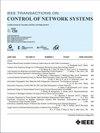Pseudorange Rigidity and Solvability of Cooperative GNSS Positioning
IF 4
3区 计算机科学
Q2 AUTOMATION & CONTROL SYSTEMS
引用次数: 0
Abstract
Global Navigation Satellite Systems (GNSS) are a widely used technology for positioning and navigation. GNSS positioning relies on pseudorange measurements from satellites to receivers. A pseudorange is the apparent distance between two agents deduced from the time-of-flight of a signal sent from one agent to the other, because of the lack of synchronization between the agents' clocks, it is a biased version of their distance. In this article, we introduce a new rigidity theory adapted to pseudorange measurements. The peculiarity of pseudoranges is that they are asymmetrical measurements. Therefore, unlike other usual rigidities, the graphs of pseudorange frameworks are directed. In this article, pseudorange rigidity is proved to be a generic property of the underlying undirected graph of constraints. The main result is a characterization of rigid pseudorange graphs as combinations of rigid distance graphs and connected graphs. This new theory is adapted for GNSS. It provides new insights into the minimum number of satellites needed to locate a receiver and is applied to the localization of GNSS cooperative networks of receivers. The interests of asymmetrical constraints in the context of formation control are also discussed.伪范围刚度与全球导航卫星系统合作定位的可解决性
全球卫星导航系统(GNSS)是一种应用广泛的定位和导航技术。GNSS定位依赖于从卫星到接收机的伪距测量。伪距是从一个智能体发送到另一个智能体的信号的飞行时间推断出的两个智能体之间的表观距离,由于智能体的时钟之间缺乏同步,它是它们距离的偏差版本。在本文中,我们引入了一种新的适用于伪距测量的刚性理论。伪量的特点是它们是不对称的测量。因此,与其他通常的刚性不同,伪框架的图是有向的。本文证明了伪距刚性是约束的底层无向图的一般性质。主要结果是将刚性伪距图描述为刚性距离图和连通图的组合。这个新理论适用于GNSS。它为定位接收器所需的最少卫星数量提供了新的见解,并应用于GNSS接收器合作网络的定位。本文还讨论了非对称约束在群体控制中的作用。
本文章由计算机程序翻译,如有差异,请以英文原文为准。
求助全文
约1分钟内获得全文
求助全文
来源期刊

IEEE Transactions on Control of Network Systems
Mathematics-Control and Optimization
CiteScore
7.80
自引率
7.10%
发文量
169
期刊介绍:
The IEEE Transactions on Control of Network Systems is committed to the timely publication of high-impact papers at the intersection of control systems and network science. In particular, the journal addresses research on the analysis, design and implementation of networked control systems, as well as control over networks. Relevant work includes the full spectrum from basic research on control systems to the design of engineering solutions for automatic control of, and over, networks. The topics covered by this journal include: Coordinated control and estimation over networks, Control and computation over sensor networks, Control under communication constraints, Control and performance analysis issues that arise in the dynamics of networks used in application areas such as communications, computers, transportation, manufacturing, Web ranking and aggregation, social networks, biology, power systems, economics, Synchronization of activities across a controlled network, Stability analysis of controlled networks, Analysis of networks as hybrid dynamical systems.
 求助内容:
求助内容: 应助结果提醒方式:
应助结果提醒方式:


